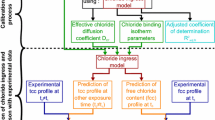Abstract
The paper presents a wide range of experimental data of the authors and of other researchers on acid-soluble chloride diffusion in different mixes of concrete, and shows conclusively that the chloride diffusion coefficient Dc is strongly dependent on the period of exposure of concrete to a chloride environment. Consequently, long term prediction of chloride concentrations on the basis of Fick's second law of diffusion, which inherently assumes a constant value of Dc, is not an accurate procedure. A differential equation is derived based on the above law of diffusion, which takes into account the time variation of Dc, and a procedure is outlined for the accurate prediction of long term chloride concentrations in concrete. The chloride concentration profiles derived using this procedure show good correlation with experimental data.
Resume
On présente, dans cet article, un large éventail de données expérimentales recueillies par les auteurs et par d'autres chercheurs sur la diffusion du chlorure soluble dans l'acide dans différents mélanges de béton, et on montre, en conclusion, que le coefficient de diffusion du chlorure Dc dépend fortement du temps d'exposition du béton à l'action du chlorure. Par conséquent, la prédiction à long terme de la concentration en chlorure sur la base de la seconde loi de diffusion de Fick, qui implique une valeur constante de D, n'est pas une méthode précise. On a élaboré ici une équation différentielle modifiée sur la base de la loi de diffusion en question, qui prend en compte la variation de Dc avec le temps. On définit une méthode permettant de prédire avec sûreté les concentrations de chlorure dans le béton. Les profils de concentration en chlorure obtenus par cette méthode montrent une bonne concordance avec les résultats d'essai.
Similar content being viewed by others
References
Crank, J., ‘The Mathematics of Diffusion’ (Oxford University Press, London, 1975) p. 414.
Roberts, M. H., ‘Carbonation of concrete made with dense natural aggregates’, BRE Information Paper, IP6/81, April 1981.
Haynes, H. H., ‘Permeability of Concrete in Sea Water’, SP-65 (American Concrete Institute, Detroit, 1982).
Conjeaud, M. L., ‘Mechanism of Sea Water Attack on Cement Mortar’ (American Concrete Institute, Detroit) pp. 39–62.
Buenfeld, N. R. and Newman, J. B., ‘Examination of three methods for studying ion diffusion in cement pastes, mortars and concrete’,Mater. Struct. 20 (1987) 3–10.
Idem,,Mag. Concr. Res. 36 (1984) 67.
Mangat, P. S. and Gurusamy, K., ‘Chloride diffusion in steel fibre reinforced marine concrete’,Cement Concr. Res. 17 (1987) 385–396.
Idem ‘Chloride diffusion in steel fibre reinforced concrete containing PFA’,Ibid 17 (1987) 640–650.
Mangat, P. S. and Molloy, B. T., ‘Factors influencing chloride induced corrosion of reinforcement in concrete’,Mater. Struct. 25 (1992) 404–411.
Chandler, K. A., ‘Marine and Offshore Corrosion’, (Butterworth, London, 1985).
Dixon, W. J., ‘BMDP Statistical Software’ (University of California Press, 1985).
Lawrence, C. D., ‘Chloride Ingress into Concrete’, (British Cement Association, Slough, UK, 1989).
Author information
Authors and Affiliations
Rights and permissions
About this article
Cite this article
Mangat, P.S., Molloy, B.T. Prediction of long term chloride concentration in concrete. Materials and Structures 27, 338–346 (1994). https://doi.org/10.1007/BF02473426
Issue Date:
DOI: https://doi.org/10.1007/BF02473426




